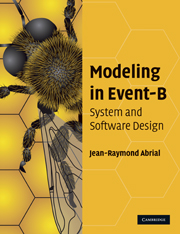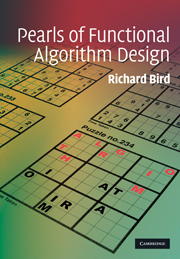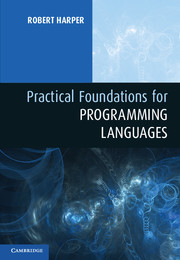Refine search
Actions for selected content:
5849 results in Programming Languages and Applied Logic
Index
-
- Book:
- Non-Hausdorff Topology and Domain Theory
- Published online:
- 05 May 2013
- Print publication:
- 28 March 2013, pp 484-491
-
- Chapter
- Export citation

Modeling in Event-B
- System and Software Engineering
-
- Published online:
- 05 March 2013
- Print publication:
- 13 May 2010

Pearls of Functional Algorithm Design
-
- Published online:
- 05 March 2013
- Print publication:
- 16 September 2010

Practical Foundations for Programming Languages
-
- Published online:
- 05 February 2013
- Print publication:
- 17 December 2012
15 - Inductive and Coinductive Types
- from Part V - Infinite Data Types
-
- Book:
- Practical Foundations for Programming Languages
- Published online:
- 05 February 2013
- Print publication:
- 17 December 2012, pp 109-115
-
- Chapter
- Export citation
5 - Dynamics
- from Part II - Statics and Dynamics
-
- Book:
- Practical Foundations for Programming Languages
- Published online:
- 05 February 2013
- Print publication:
- 17 December 2012, pp 36-44
-
- Chapter
- Export citation
14 - Generic Programming
- from Part IV - Finite Data Types
-
- Book:
- Practical Foundations for Programming Languages
- Published online:
- 05 February 2013
- Print publication:
- 17 December 2012, pp 102-106
-
- Chapter
- Export citation
Contents
-
- Book:
- Practical Foundations for Programming Languages
- Published online:
- 05 February 2013
- Print publication:
- 17 December 2012, pp v-xvi
-
- Chapter
- Export citation
Part XIII - State
-
- Book:
- Practical Foundations for Programming Languages
- Published online:
- 05 February 2013
- Print publication:
- 17 December 2012, pp 283-284
-
- Chapter
- Export citation
Part VI - Dynamic Types
-
- Book:
- Practical Foundations for Programming Languages
- Published online:
- 05 February 2013
- Print publication:
- 17 December 2012, pp 125-126
-
- Chapter
- Export citation
Part XVIII - Equational Reasoning
-
- Book:
- Practical Foundations for Programming Languages
- Published online:
- 05 February 2013
- Print publication:
- 17 December 2012, pp 411-412
-
- Chapter
- Export citation
12 - Sum Types
- from Part IV - Finite Data Types
-
- Book:
- Practical Foundations for Programming Languages
- Published online:
- 05 February 2013
- Print publication:
- 17 December 2012, pp 86-92
-
- Chapter
- Export citation
39 - Nested Parallelism
- from Part XV - Parallelism
-
- Book:
- Practical Foundations for Programming Languages
- Published online:
- 05 February 2013
- Print publication:
- 17 December 2012, pp 325-336
-
- Chapter
- Export citation
9 - Gödel's T
- from Part III - Function Types
-
- Book:
- Practical Foundations for Programming Languages
- Published online:
- 05 February 2013
- Print publication:
- 17 December 2012, pp 64-70
-
- Chapter
- Export citation
45 - Type Abstractions and Type Classes
- from Part XVII - Modularity
-
- Book:
- Practical Foundations for Programming Languages
- Published online:
- 05 February 2013
- Print publication:
- 17 December 2012, pp 387-398
-
- Chapter
- Export citation
18 - Dynamic Typing
- from Part VI - Dynamic Types
-
- Book:
- Practical Foundations for Programming Languages
- Published online:
- 05 February 2013
- Print publication:
- 17 December 2012, pp 134-141
-
- Chapter
- Export citation
Part XVII - Modularity
-
- Book:
- Practical Foundations for Programming Languages
- Published online:
- 05 February 2013
- Print publication:
- 17 December 2012, pp 381-382
-
- Chapter
- Export citation
34 - Dynamic Classification
- from Part XII - Symbols
-
- Book:
- Practical Foundations for Programming Languages
- Published online:
- 05 February 2013
- Print publication:
- 17 December 2012, pp 276-282
-
- Chapter
- Export citation
35 - Modernized Algol
- from Part XIII - State
-
- Book:
- Practical Foundations for Programming Languages
- Published online:
- 05 February 2013
- Print publication:
- 17 December 2012, pp 285-294
-
- Chapter
- Export citation
17 - The Untyped λ-Calculus
- from Part VI - Dynamic Types
-
- Book:
- Practical Foundations for Programming Languages
- Published online:
- 05 February 2013
- Print publication:
- 17 December 2012, pp 127-133
-
- Chapter
- Export citation
